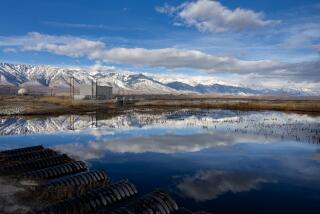Unusually Dry Winter Linked to Return of El Nino
It isn’t a drought yet, but if you think it’s been a lot drier than usual this winter, you’re right.
During December and January, normally two of the wettest months, only 1.11 inches of rain fell on Los Angeles, compared to a normal total of 4.95 inches. The total so far for the season, which began July 1, is only 1.93 inches, compared to an average total through Feb. 1 of 7.93 inches.
Forecasters say it all probably has something to do with El Nino , the little-understood weather phenomenon that usually means more rain than usual, but this year apparently means a lot less.
“It’s a very unpredictable thing,” Curtis Brack, a meteorologist with WeatherData Inc., admitted during a telephone interview. “I’m not sure what to say.”
Last fall, one of Brack’s associates, fellow WeatherData meteorologist James McCutcheon, noted that photographs from National Oceanographic and Atmospheric Administration satellites had confirmed a return of El Nino-- a reversal of the normal trade-wind patterns that cause the pooling of warm water off Peru.
McCutcheon said that for reasons not fully understood, El Nino usually leads to a strengthening of the subtropical jet steam north of the Equator. When that happens, masses of warm, moist air off the east coast of Hawaii start drifting toward Southern California, bringing with them increasing chances of substantial rain.
That’s what happened last winter, when Southern California and Baja California were hammered by storms that caused disastrous flooding. When McCutcheon saw three months ago that El Nino was back, he saw a good chance of more of the same.
“If you had to make your wager right now, I’d bet on another wet winter in Southern California,” he said at the time.
Fortunately for McCutcheon, he’s not a gambler.
“This year, high-pressure ridge after high-pressure ridge has been developing along the West Coast, blocking the storm systems from reaching Southern California,” Brack said. “ El Nino supposedly is still there, but it’s not doing what it usually does. This year it seems to be causing dry weather.”
Bruce Thoren, another WeatherData meteorologist, said Wednesday there could be a few light showers here tonight and early Friday.
Nonetheless, Brack is still optimistic about the prospects of rain in coming months. But even if this springs’s rains don’t amount to much--and despite relatively little snow in the eastern High Sierra, source of much of the city’s drinking water--continuing conservation and a surplus from last year’s heavy rains mean Los Angeles will have plenty of water this summer, city officials say.
More to Read
Sign up for Essential California
The most important California stories and recommendations in your inbox every morning.
You may occasionally receive promotional content from the Los Angeles Times.









